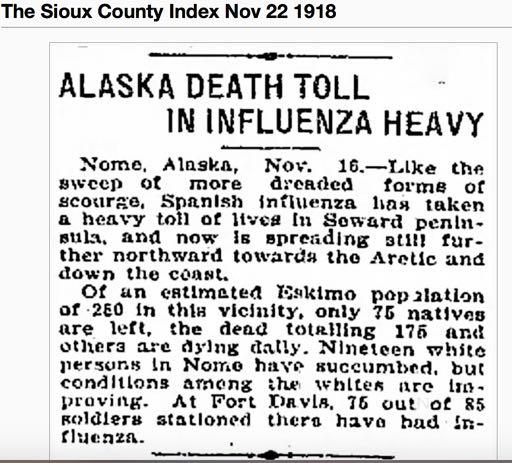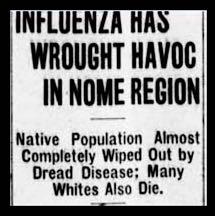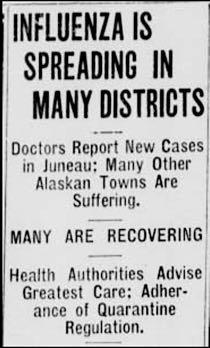
5 minute read
THE 1918 INFLUENZA EPIDEMIC


Advertisement

Maynard Columbus Hospital staff in uniform standing on hospital porch, in Nome between 1910 and 1920. Lomen Brothers photograph, public domain.
The 1918 Influenza Epidemic
The 1918-19 influenza pandemic saw an estimated 500 million people, one-third of the world’s population, become infected with the virus. There were an estimated 50 million deaths worldwide, with around 675,000 deaths in the United States. Alaska was hit hard.
In January, 1919, hearings were held before the Subcommittee of the House Committee on Appropriations in Charge of Relief in Alaska and Porto Rico (as the southernmost territory was spelled at that time). Appearing before the committee would be the Governor of Alaska, Thomas Riggs, Jr., a former engineer, surveyor, and one of three commissioners who had overseen the construction of the Alaska Railroad. He had been in office less than a year. Appearing with him was P. P. Claxton, Alaska’s Commissioner of Education.
The opening of the hearing can be read on page 8. At that point Mr. Sisson interrupted Mr. Riggs, asking how much of the education fund had been used. Mr. Claxton explained that all of the funds which had not been already allotted for other purposes had been exhausted.
MR. RIGGS: The surgeon general of the Public Health Service, who had an appropriation of $1,000,000 to combat influenza, authorized me to engage doctors and nurses where I could get them and that was done as to the ice-free portion of Alaska, but, of course, we could not reach the ice-bound portions. I have authorized, where I have had any funds with which to do it, the sending of relief expeditions for the gathering up of these orphans and have contracted for their keep; I have authorized the purchase of provisions for the indigent natives because they are not allowed to travel and trap, and, as a matter of fact, most of them are dead. For instance, at Cape Prince of Wales, of a population of 300 natives, 5 adults were left alive; at Kodiak probably 50 per cent of the natives died; at Kakutat the surgeon general was able to reach them with a naval collier and so prevent very many deaths, and all along the line I have been controlling travel among the natives so that the disease would not get to the more isolated natives and affect the white population. I have kept the disease well out of Fairbanks, Iditarod, and the Yukon River country. I have authorized up to date about $107,000. The territorv had a small fund of $5,000 for the control of epidemics but that was gone in no time at all. If it were merely for the relief of the white population I should not come to Congress for 1 cent. 1 should put that on the territory where, I think, it rightly belongs, but when it comes to what we consider the wards of the Nation, who are not taxpayers and who, in other parts of the United States, are attended to by the Government, I consider that our small treasury should not be diminished by the sum necessary. We need that for our schools and roads; we have not a very large treasury, and we can not handle it ourselves: it has gone beyond our control.There were approximately 2,000 deaths, as I figure it, in Alaska from influenza, which are scattered all over the Territory. The Territory is two and a quarter times the size of Texas, and many places there are without any means of communication. I sent one doctor 400 miles by dog team, an expensive trip. He got to the afflicted community and died.

MR. WOOD: The doctor died?
MR. RIGGS: Yes. Of influenza.
After discussions about how many had died and where, with Gov. Riggs pointing out that the influenza was affecting the Native population more violently than the whites, the talk focused on what would be done with the money. Gov. Riggs noted that he had originally asked for $200,000, but that amount had been cut in half in the Senate. He stated that he had asked the Red Cross for relief, but “did not receive any encouragement from that quarter.”
Asked about recent news from Alaska, Gov. Riggs read from a letter dated January 2, 1919, from Nome: “Ten villages this district affected. Three wiped out entirely, others average 85 per cent deaths. Majority of children of affected villages saved by relief parties sent by te Bureau of Education. Teachers in stricken villages all sick, two dead, rest recovering. Total number of deaths reported 750, probably 25 per cent this number frozen to death before help arrived. Over 500 children to be cared for, majority of whom are orphans. Am feeding and caring for surviving population of five large villages. Seven relief hospitals operated in affected villages; no trained nurses or physicians available, but splendid work done by white people in charge. Cost to date estimated $70,000 for native relief alone; will need about . $15,000 this month. May be necessary send relief several quarantined villages owing to regulations preventing natives from trapping, and can not purchase necessities. Impossible at this time to lift quarantine zones in outlying affected villages. Appalling and beyond description. Am giving 90 orphans to mission at Nome to care for at $10 per month, but hope department will plan for large industrial training school this district next summer. Splendid opportunity for educational advancement for the Eskimos.”
Mr. Sisson asked why the Eskimos were not trapping, to which Gov. Riggs replied that most of them were dead, the others either ill or quarantined in their villages.
Mr. Sisson asked how supplies and materials had been obtained thus far, and Gov. Riggs replied, “On my personal credit, my personal word it would be paid, as Governor of Alaska.”
There was then lengthy discussion of many related issues, blunt questions, patient answers, concerns about setting precdents, accounting, and the potential for misappropriation of the funds.
Mr. Sisson asked about expenses again, and Gov. Riggs told of sending dog teams from Nome to Kotzebue, 10 men, 3 dogteams, at a cost of $3,000. “It costs $1 a day to feed a dog.”
Mr. Riggs noted there were around 20,000 white people in Alaska, and Mr. Sisson asked, “You have more Indians than white people?” To which Gov. Riggs replied “Yes, about 27,000,” and Mr. Claxton commented, “Probably a few more than that.”
Possibly feeling exasperated, Gov. Riggs stated, “These are our own people; they are not from Austria, Turkey, Belgium, or Serbia; our own American people, who belong to us. It is a very serious situation.” •~•







